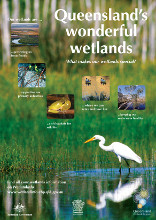|
|
WetlandInfo—your first-stop-shop for wetland management resources in QueenslandSelect the area type
WetlandSummary—facts and mapsFind wetland information for regions of Queensland. WetlandSummary provides:
WetlandUpdate May 2025Read the full newsletter (with pages links) or subscribe. New pagesUpdated pages and toolsWetlands Mapping Version 7.0
Litter and Illegal Dumping Management Framework
WetlandMaps and WetlandSummary
Programs, policy and legislation
New and updated documentsWetlands Mapping Method Version 2.1
Wetlands Definition Guideline 2.1
GBRF Integrated synthesis report
Additional links
We value your input and feedback so please email us your comments, wetland information and links or that wetland question you just can't answer. Wonderful wetlandsWetlands are important for our environment, economy and our livelihoods. They have many functions from reducing floods to producing clean water and food for humans, industry and agriculture. They provide important habitat for many animals and plants. Wetlands are the great ‘connectors’ across our landscape providing places for our enjoyment and relaxation. Regardless of whether you are doing a school or uni assignment, managing a wetland or undertaking research, you will find a wealth of information here on WetlandInfo. Read more… WetlandInfo feature speciesThe southern purple-spotted gudgeon (Mogurnda adspersa) is a small, freshwater, carnivorous fish found across east and south-eastern Australia. These fish are characterised by broad blueish bands overlaid with numerous small tan, orange and purple spots along their sides (more prominent during breeding periods) and three horizontal, red bars along either side of their faces. This species of gudgeon can grow up to 13cm in length but, normally, when found as adults, they are approximately 8cm long. They are found in small, slow-flowing wetland systems, typically hidden amongst aquatic vegetation, rocks and woody structures. During breeding, females lay batches of eggs up to 1,300 and place them on underwater objects. Once laid, male fish guard them until they hatch, which can take between 3-9 days, depending on conditions. The species saw significant declines in populations throughout South Australia, Victoria, and New South Wales during the 1980's due to introduced predatory species, competition for food sources, and changes to their habitats that impacted on breeding processes. Populations in Queensland appear to be relatively stable. Additional information |

 — Department of the Environment, Tourism, Science and Innovation
— Department of the Environment, Tourism, Science and Innovation



